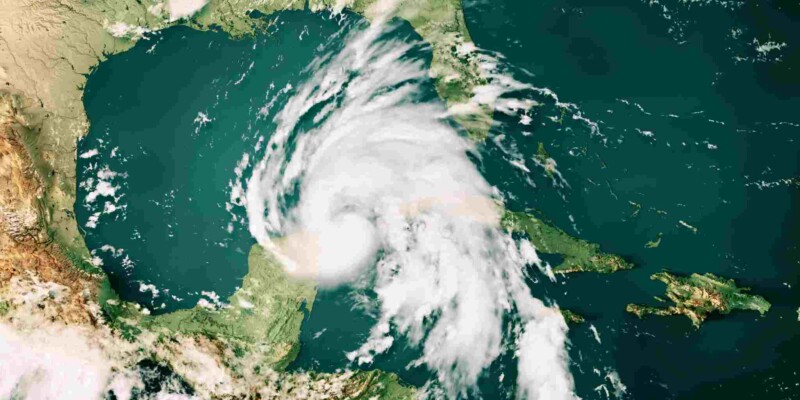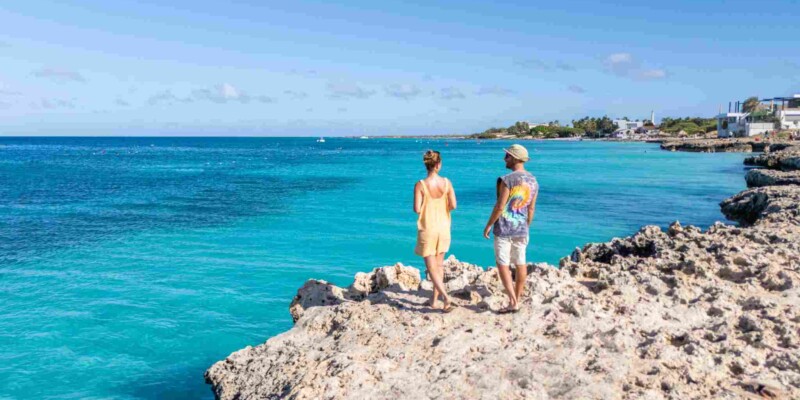How to Prepare, Stay Safe, and Choose the Right Coverage for Your Trip

However, tropical storms can also bring sudden cancellations, rerouted itineraries, or even evacuations. That’s why smart preparation and the right hurricane travel insurance are essential.
This article shows you how to plan wisely, stay safe during storm season, choose the right coverage, and even discover destinations ideal for off-season travel.

Find the Best International Travel Insurance
- Get multiple quotes and coverage options
- Travel Medical, Trip Cancellation & more options available
- Find the best plan for your needs and budget
TL;DR — Key Takeaways
- Off-season travel offers cheaper trips, fewer crowds, and beautiful scenery, but also carries risks such as cancellations, delays, and evacuations.
- Buy hurricane travel insurance as soon as you book your trip, as coverage for trip cancellations, emergency medical care, or evacuation only applies if you purchase it before a storm is named.
- When traveling to storm-prone areas, track weather forecasts, know evacuation routes, and make bookings with changeable or refundable options.
- Before you leave, pack an emergency kit, secure important documents, and sign up for travel alerts, such as the U.S. STEP Program.
- If you’re planning a cruise, secure trip protection insurance to cover rerouted itineraries, delays, or unused portions of your voyage, since refund policies vary by cruise line.
What Is a Hurricane?
A hurricane is a powerful tropical storm with swirling winds of at least 74 mph, heavy rain, and thunderstorms.
These storms form over warm ocean waters and are collectively called tropical cyclones. Depending on where they form, they are known by different names:
- Hurricanes: North Atlantic, Caribbean, Gulf of Mexico, U.S. coasts, and Central/East Pacific
- Typhoons: Northwest Pacific (East and Southeast Asia)
- Tropical Cyclones: South Pacific, Indian Ocean, Australia, Madagascar, and East Africa
When Is Hurricane Season?
In most of the Americas, storm season runs from June 1 to November 30, though exact dates vary by ocean basin.

Here’s a breakdown by region:
North Atlantic (U.S. Caribbean, Gulf of Mexico)
- Season: June 1 – November 30
- Peak: August to October
- Main Areas: Florida, Texas, Gulf Coast, Eastern Seaboard, Bahamas, Cuba, Puerto Rico, Mexico, Caribbean, Central America
Eastern Pacific
- Season: May 15 – November 30
- Peak: July to September
- Main Areas: Pacific coast of Mexico, Central America, Hawaii (occasional storms)
Central Pacific
- Season: June 1 – November 30
- Peak: July to September
- Main Areas: Hawaii, Johnston Atoll, U.S. Pacific territories
Other Global Storm Seasons
Tropical cyclones occur at different times around the world, such as:
- Northwest Pacific (Typhoons): May to October, peak in August (Japan, Philippines, China, Taiwan, Vietnam)
- South Pacific: November to April, peak late February to March (Fiji, Vanuatu, Tonga, Australia)
- North Indian Ocean: April to December, peak May to November (India, Bangladesh, Sri Lanka, Oman)
- Southwest Indian Ocean: November to April, peak January to March (Madagascar, Mozambique, Mauritius)
- Southeast Indian Ocean: October to May, peak January to March (Western Australia, Indonesia)

How Are Hurricanes Measured?
The National Hurricane Center (NHC) and Central Pacific Hurricane Center (CPHC) use the Saffir-Simpson Hurricane Wind Scale to classify these storms based on their sustained wind speeds.
This five-category system estimates the potential damage caused by these winds:
| Category | Sustained Winds | Potential Damage |
|---|---|---|
| 1 | 74–95 mph | Very dangerous winds, some property damage possible |
| 2 | 96–110 mph | Extremely dangerous winds, extensive damage likely |
| 3 | 111–129 mph | Devastating damage expected |
| 4 | 130–156 mph | Catastrophic damage |
| 5 | 157 mph or higher | Catastrophic damage, highest risk level |
Understanding these categories helps travelers better assess risk levels and prepare accordingly.
Hurricane Watches and Warnings
There are two types of alerts that travelers should know:
- Hurricane Watch: Conditions are possible. Typically issued about 48 hours before tropical-storm-force winds (39–73 mph) may begin.
- Hurricane Warning: Conditions are expected. Usually announced around 36 hours in advance, giving you time to complete final preparations.
How Hurricanes Can Disrupt Travel Plans
Severe weather can quickly derail even the best-planned trip. Common travel disruptions include:
- Flight cancellations and airport closures due to strong winds and flooding
- Cruise and ferry interruptions if ships must reroute or suspend services
- Road closures caused by fallen debris, flooding, or landslides
- Infrastructure damage, such as downed power lines or delayed emergency services

We’ll Help You Choose the Right Travel Plan
Compare top-rated travel insurance plans for your upcoming trip abroad.
Why Travel Insurance Matters During Hurricane Season
Without appropriate travel insurance, you risk losing non-refundable expenses, such as flights, accommodations, and excursions, when a hurricane strikes.
Moreover, you could face steep medical bills or emergency evacuation costs that can reach tens of thousands of dollars.
The right policy protects your investment, covering both trip cancellations and emergency medical care or evacuation, so you can travel with confidence during storm season.
Recent statistics highlight just how valuable this coverage can be. According to 2024 data from Squaremouth, traveler purchases of storm protection policies rose 58% year-over-year, and 40% of claims were for weather-related cancellations, with medical evacuations averaging $17,000.

Key Benefits to Look for in a Policy
To ensure you have full protection, look for these features when purchasing hurricane travel insurance:
- Cancel For Any Reason (CFAR) Coverage: Lets you cancel your trip for reasons not normally covered, such as personal concerns or changing plans. CFAR typically reimburses 50–75% of prepaid, non-refundable costs.
- Trip Cancellations or Delays: Covers your trip if your destination is under a hurricane warning, becomes uninhabitable, or mandatory evacuations are issued.
- Extra Expenses: Reimburses costs for accommodations, meals, or rebooking if flights are delayed due to weather-related disruptions.
- Lost or Damaged Baggage: Protects your personal belongings during travel interruptions.
- Emergency Medical Treatment and Evacuation: Covers injury, illness, or mandatory evacuation, ensuring you get care when needed.
What’s Typically Excluded
- Any storm officially named before you purchased your policy.
- Ignoring official travel warnings or evacuation orders.
- Canceling only for fear that a storm may disrupt your trip (unless you have CFAR).
- Losses from unlawful or high-risk activities.
- Trip cancellations or medical expenses related to undeclared pre-existing conditions.
Read your travel insurance policy carefully to understand what is and isn’t covered. Check exclusions and deadlines, and clarify any unclear terms with your insurer.
The Best Travel Insurance for Hurricane Season
Below are our recommended travel plans, based on nationality, to help you find the right coverage.
Our Recommended Plans for US Residents
Trawick Safe Travels Voyager – Comprehensive Trip Protection Coverage

Safe Travels Voyager
- Valid for U.S. citizens/residents traveling within the U.S. and/or internationally
- Comprehensive coverage for trip cancellation, trip interruption, emergency medical and post-departure travel coverage
- Cancel for Any Reason (CFAR) available
For added protection, the Trawick Safe Travels AnyReason plan includes CFAR coverage at no extra cost when U.S. residents purchase within 7 days of their initial trip deposit.
GeoBlue Voyager Choice – Travel Health Plan with Pre-Existing Conditions Coverage

GeoBlue Voyager Plan
- For U.S. citizens and residents up to age 95
- Includes pregnancy coverage, baggage loss, trip interruption & more
- 24/7/365 service and assistance
Our Recommended Plans for All Nationalities
World Nomads – Trip Protection Plan with Robust Coverage for Adventure Activities

World Nomads Travel Insurance for Trip Cancellation
- Trip cancellation and interruption benefits included
- Emergency medical transport and repatriation
- Baggage and gear cover
- Optional Cancel For Any Reason (CFAR) coverage available for U.S. citizens/residents (Explorer and Epic Plans)
IMG Patriot Platinum – Travel Health Plan with High Maximum Limits and Premium Benefits

Patriot Platinum Travel Insurance
- Maximum limits up to $8,000,000
- IMG pays 100% of medical expenses in-network
- Evacuation due to Natural Disasters & Political Unrest
Cruise Travel During Hurricane Season
If you’re planning a cruise during this season, it’s important to be prepared for possible itinerary changes. Cruise lines closely monitor weather forecasts, and passenger safety is always the top priority.
If a storm is approaching, ships may reroute, delay arrivals, swap ports, or remain at sea until it’s safe. These changes can occur with little notice, so be ready to adjust plans.
Modern ships are designed to withstand severe weather. They feature stabilizers, reinforced hulls, and highly trained crews that conduct regular emergency drills. Crew members may ask passengers to remain indoors during a storm.
Passenger Safety Tips
Here are some practical tips to help you stay safe and comfortable during cruises in rough seas:
- Keep essential documents, medications, and valuables in a carry-on or easily accessible bag.
- Follow all instructions from the crew and stay aware of onboard alerts.
- Stay flexible with your schedule, as ports of call or arrival times may change.
- Pack snacks, water, and entertainment to make time indoors more comfortable if rough seas or storm delays occur.
- Stay in touch with your travel companions and maintain a designated meeting spot in case of separation.
For more practical advice, see our article on Cruise Tips for Beginners and Pros
Handling Itinerary Changes and Refunds
Each cruise line has its own policy. If itineraries change but the voyage continues, passengers may receive prorated refunds, onboard credits, or discounts on future trips.
If the sailing is canceled entirely, most companies offer either a full refund or credit toward another cruise.
Always read the terms and conditions before booking, and ensure your cruise insurance provides coverage for weather-related interruptions to protect your trip and investment.
We recommend the following plan.
Cruise Trip Protection Insurance with Emergency Medical Coverage

Cruise Trip Protection Insurance
- Available to U.S. residents taking domestic or international cruises
- 100% Trip Cancellation and Trip Interruption Coverage
- Emergency Evacuation and Repatriation
- 75% of Cancel for Any Reason (CFAR) is included within 7 days of trip deposit
The Safest Places to Travel During Hurricane Season
Despite the risks, many travelers still choose to vacation during tropical storm months, and the numbers are rising.
AAA projected a 2.4% increase in summer travel for 2025, with over 61 million Americans hitting the road for Independence Day weekend alone.
The good news is that you can still enjoy off-season travel while minimizing risk. By choosing destinations located outside the hurricane belt or in regions with historically lower storm activity, you can experience great weather and plenty of attractions without the stress of severe weather disruptions.
These safer travel spots combine relaxation, sightseeing, and adventure, making them ideal for travelers seeking an off-season getaway.
Caribbean Islands Outside the Hurricane Belt
ABC Islands (Aruba, Bonaire, Curaçao)
Located near South America, these islands sit below the hurricane belt and rarely experience direct storm impacts.
Southern Caribbean (Barbados, Saint Lucia, Antigua)
While technically within the hurricane zone, these islands tend to face fewer direct hits than northern Caribbean destinations.
Mediterranean Europe
Spain, Italy, and Greece
These popular summer destinations have stable weather patterns and no risk of hurricanes, making them perfect for beach, culture, and city travel during storm season in the Americas.
U.S. Inland Cities
Atlanta, Dallas, Denver, Minneapolis, Salt Lake City, Phoenix, and Chicago
Far from coastal storm threats, these cities offer vibrant cultural scenes, dining, and attractions, making them ideal alternatives for domestic travelers.
Southeast Asia
Bali, Thailand, Vietnam, Cambodia, Malaysia, Singapore
These destinations have storm seasons that peak at different times than the Atlantic hurricane season, making them ideal off-season travel options. They also offer vibrant culture, stunning landscapes, and fewer crowds during these periods.
Safety Tips for Traveling During Hurricane Season
Even if you’re prepared and insured, it’s important to stay alert while traveling during hurricane season.
Here are a few key steps:
- Stay Informed: Monitor weather alerts and local advisories regularly.
- Pack Essentials: Keep important documents, medications, and emergency supplies easily accessible.
- Plan for Flexibility: Choose refundable or changeable bookings and know evacuation routes and local shelters.
For a detailed, step-by-step guide on what to do before, during, and after a hurricane, see our article on What to Do if You Experience a Natural Disaster Abroad.
The Best Tools for Hurricane Season Travelers
These resources can help you monitor the weather, track travel changes, and access emergency support while traveling:
- NOAA National Hurricane Center – Official hurricane forecasts, advisories, and storm tracking for Atlantic and Pacific regions.
- FEMA App – Provides emergency alerts, shelter locations, and disaster preparedness resources (available on iOS & Android).
- STEP (Smart Traveler Enrollment Program) – Register your travel with the U.S. State Department to receive emergency alerts and assistance abroad.
- The Weather Channel App – Provides real-time weather and storm alerts, including hurricane updates.
- Airline Alert Pages/Apps – Track flight status, cancellations, and waivers directly from major carriers during the season.
- U.S. Embassy/Consulate Info – Emergency contact information and travel alerts from U.S. embassies worldwide.
- Cruise Line Websites/Apps – Updates on itinerary changes, rerouting, and safety during hurricane season cruises.
Other Resources and Checklists
The following organisations also offer detailed checklists and information on how to prepare for a hurricane:
- U.S. Coast Guard Hurricane Guide
- American Red Cross Hurricane Preparedness
- FEMA Hurricane Preparation
- CDC Hurricane Safety Information
Stay Prepared and Protected During Severe Weather
Traveling during hurricane season offers unique rewards, including fewer crowds, better prices, and striking natural scenery.
However, it also carries real risks, from cancellations and rerouted itineraries to potential evacuations or medical emergencies.
Preparation is key to a safe, stress-free trip. This means securing hurricane travel insurance early, monitoring weather forecasts, keeping plans flexible, and packing emergency essentials.
The right policy protects your trip investment, provides access to medical care, and covers emergency evacuations, so you can travel with confidence.
By following the guidance in this article, such as choosing safe destinations, preparing for severe storms, and understanding your coverage options, you can enjoy off-season travel while minimizing risk and maximizing peace of mind, no matter what the weather brings.
Emergency Evacuation Insurance Plan with 24/7 Travel Security Benefits

MedjetHorizon Travel Protection
- 24/7 Travel Security Response and Evacuation Services
- All-Expenses-Paid Air Medical Transport in the U.S. and Internationally
- Available to residents of the United States, Canada and Mexico under the age of 75
- Covers Business and Personal Travel
Frequently Asked Questions
Does travel insurance cover tropical storms and hurricanes?
Yes, most comprehensive travel insurance policies cover trip cancellations, delays, interruptions, medical emergencies, and evacuations caused by severe weather, provided you purchase the policy before the storm is named.
What happens if bad weather disrupts my trip?
If a tropical storm delays your journey or cuts it short, travel insurance can reimburse extra costs for hotels, meals, or transportation, as well as unused prepaid expenses. Always keep receipts and notify your insurer promptly.
When should I buy travel insurance for storm protection?
Buy as soon as you book your trip. If you wait until after a storm is named, you won’t be covered.
What is Cancel For Any Reason (CFAR) coverage?
CFAR is an optional add-on that lets you cancel for reasons not typically covered, such as concern about an approaching storm. It usually reimburses 50 to 75% of non-refundable costs.
Can I get a refund if my cruise itinerary changes due to tropical storms?
Cruise lines typically reroute or adjust itineraries to avoid storms. Refunds are uncommon unless the sailing is canceled, but insurance may cover unused portions of your trip.
How do I handle travel interruptions caused by severe weather?
Contact your insurer and travel providers immediately. Document expenses, keep receipts, and follow instructions on filing claims. Stay flexible with rebooking options and monitor official weather updates.
Where can I track storm activity while traveling?
Reliable sources for real-time alerts and travel advisories include NOAA’s National Hurricane Center, the FEMA app, and the U.S. State Department’s STEP program.
Don’t Get Swept Away in Medical Bills—Protect Yourself from Disaster!

Find the Best International Travel Insurance
- Get multiple quotes and coverage options
- Travel Medical, Trip Cancellation & more options available
- Find the best plan for your needs and budget
Read More
- Top 10 Travel Insurance Companies
- A Guide to Travel Advisories, Warnings, and Alerts
- Travel Insurance and Safety Advice by Country
- Is Travel Insurance Worth It?
About the Author:Magdalena Laas is a content strategist and storyteller from South Africa who has lived in New Zealand, the UK, and the Netherlands. She writes about relocation, healthcare, education, and more, always aiming to make complex topics clear and accessible. Outside of work, she’s passionate about sustainability, hiking, and planning her next adventure.


